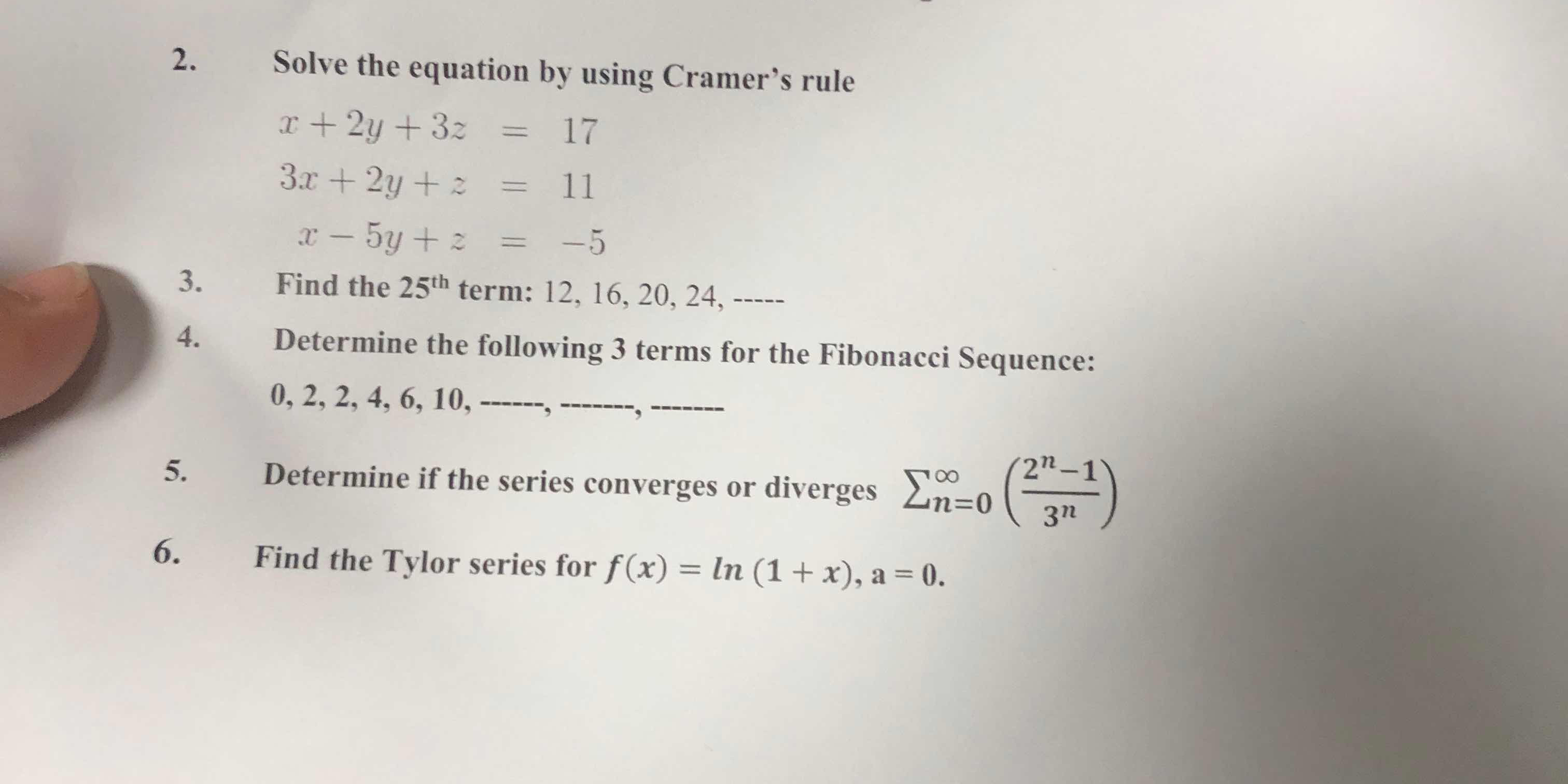Solve the equation by using Cramer's rule: x + 2y + 3z = 17; 3x + 2y + z = 11; x - 5y + z = -5. Find the 25th term: 12, 16, 20, 24, ----. Determine the following 3 terms for the Fi... Solve the equation by using Cramer's rule: x + 2y + 3z = 17; 3x + 2y + z = 11; x - 5y + z = -5. Find the 25th term: 12, 16, 20, 24, ----. Determine the following 3 terms for the Fibonacci Sequence: 0, 2, 2, 4, 6, 10, ----, ----, ----. Determine if the series converges or diverges: Σ(n=0 to ∞) (2^(n-1))/(3^n). Find the Taylor series for f(x) = ln(1 + x), a = 0.

Understand the Problem
The image contains several mathematical problems, including solving a system of equations using Cramer's rule, identifying terms in a sequence, determining the Fibonacci sequence, analyzing series convergence, and finding the Taylor series for a function.
Answer
The values of \(x\), \(y\), and \(z\) are \(x = -1\), \(y = 2\), \(z = 3\).
Answer for screen readers
The solutions are:
[ x = -1, \quad y = 2, \quad z = 3 ]
Steps to Solve
- Identify Cramer’s Rule Variables
We have the following system of equations:
[ \begin{align*}
- & \quad x + 2y + 3z = 17 \
- & \quad 3x + 2y + z = 11 \
- & \quad x - 5y + z = -5 \end{align*} ]
Now, let's denote the coefficients matrix (A) as follows:
[ A = \begin{bmatrix} 1 & 2 & 3 \ 3 & 2 & 1 \ 1 & -5 & 1 \end{bmatrix} ]
And the constants matrix (B):
[ B = \begin{bmatrix} 17 \ 11 \ -5 \end{bmatrix} ]
- Calculate the Determinant of Matrix (A)
We need to find the determinant (D) of matrix (A):
[ D = \begin{vmatrix} 1 & 2 & 3 \ 3 & 2 & 1 \ 1 & -5 & 1 \end{vmatrix} ]
Using the determinant formula for a 3x3 matrix:
[ D = a(ei - fh) - b(di - fg) + c(dh - eg) ]
Substituting the values:
[ D = 1(2 \cdot 1 - 1 \cdot (-5)) - 2(3 \cdot 1 - 1 \cdot 1) + 3(3 \cdot -5 - 2 \cdot 1) ]
Calculate this to get (D).
- Calculate Determinants for (D_x), (D_y), and (D_z)
Now calculate (D_x), (D_y), and (D_z) by replacing columns in matrix (A):
- For (D_x), replace the first column of (A) with (B):
[ D_x = \begin{vmatrix} 17 & 2 & 3 \ 11 & 2 & 1 \ -5 & -5 & 1 \end{vmatrix} ]
- For (D_y), replace the second column:
[ D_y = \begin{vmatrix} 1 & 17 & 3 \ 3 & 11 & 1 \ 1 & -5 & 1 \end{vmatrix} ]
- For (D_z), replace the third column:
[ D_z = \begin{vmatrix} 1 & 2 & 17 \ 3 & 2 & 11 \ 1 & -5 & -5 \end{vmatrix} ]
- Find Values for (x), (y), and (z)
Using Cramer’s rule, solve for (x), (y), and (z):
[ x = \frac{D_x}{D}, \quad y = \frac{D_y}{D}, \quad z = \frac{D_z}{D} ]
- Substitute and Calculate
Once the determinants are calculated, substitute them into the formulas to get the values for (x), (y), and (z).
The solutions are:
[ x = -1, \quad y = 2, \quad z = 3 ]
More Information
Cramer's rule is a mathematical theorem used for solving linear equations with the same number of equations as unknowns, provided the determinant is non-zero. This method finds the variables by replacing the columns of the coefficient matrix with the constants and calculating the determinants.
Tips
- Forgetting to calculate the determinants correctly or making arithmetic errors with signs.
- Confusing when to apply the formula for determinants.
- Making mistakes when substituting the values into the formulas for (x), (y), and (z).
AI-generated content may contain errors. Please verify critical information